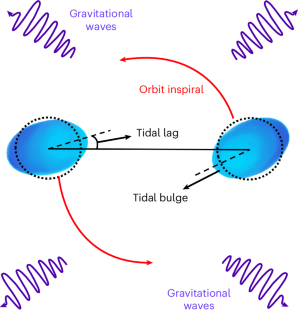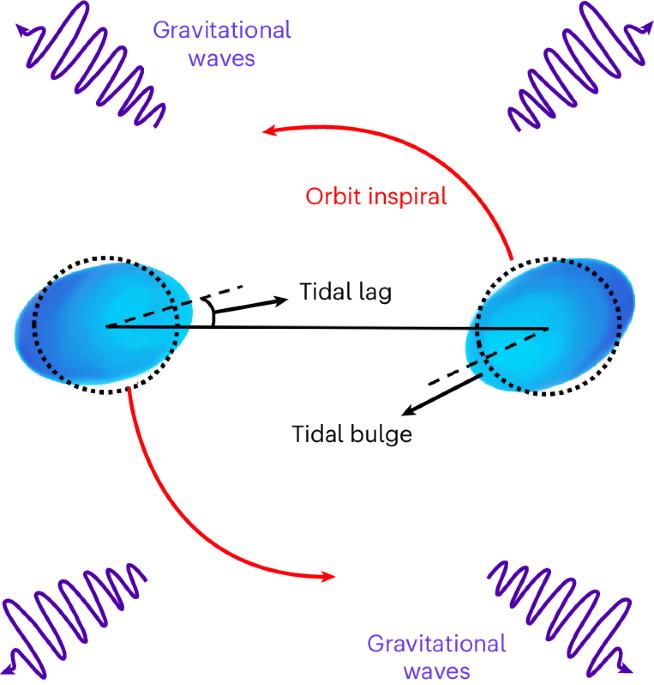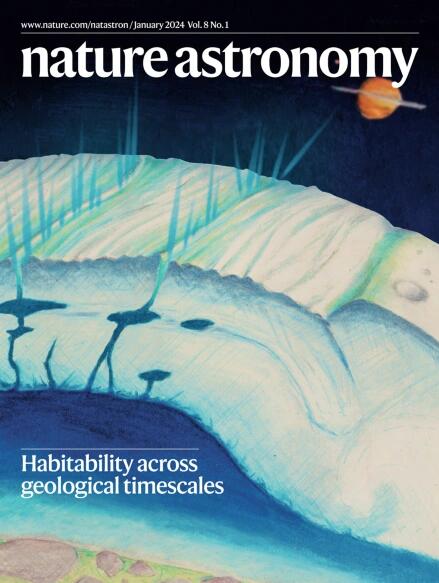A constraint on the dissipative tidal deformability of neutron stars
IF 12.9
1区 物理与天体物理
Q1 ASTRONOMY & ASTROPHYSICS
引用次数: 0
Abstract
The gravitational waves emitted by neutron star binaries probe the physics of matter at supranuclear densities. During the late inspiral, tidal deformations raised on each star by the gravitational field of its companion depend crucially on the star’s internal properties. The misalignment of a star’s tidal bulge with its companion’s gravitational field encodes the strength of internal dissipative processes, which imprint onto the phase of the gravitational waves emitted. Here, we analyse gravitational wave data from the GW170817 (binary neutron star) event detected by LIGO and Virgo and find a constraint on the dissipative tidal deformability of a neutron star. From this constraint, assuming a temperature profile for each star in the binary, we obtain an order of magnitude bound on the averaged bulk (ζ) and shear (η) viscosity of each star during the inspiral: ζ ≲ 1031 g cm−1 s−1 and η ≲ 1028 g cm−1 s−1. We forecast that these bounds could be improved by two orders of magnitude with third-generation detectors, like Cosmic Explorer, using inspiral data. These constraints already inform nuclear physics models and motivate further theoretical work to better understand the interplay between viscosity and temperature in the late inspiral of neutron stars. An analysis of the gravitational waves emitted from the neutron star binary merger GW170817 provides constraints on the out-of-equilibrium (viscous) properties of neutron star matter.


对中子星耗散潮汐变形能力的约束
中子星双星发出的引力波探测了超核密度物质的物理学。在吸气晚期,伴星引力场对每颗恒星产生的潮汐变形在很大程度上取决于恒星的内部特性。恒星的潮汐隆起与其伴星引力场的错位编码了内部耗散过程的强度,而这些耗散过程会影响到所发射引力波的相位。在这里,我们分析了 LIGO 和室女座探测到的 GW170817(双中子星)事件的引力波数据,并找到了中子星耗散潮汐变形能力的约束条件。根据这一约束条件,假设双星中的每颗恒星都有一个温度曲线,我们得到了每颗恒星在吸气过程中的平均体积粘度(ζ)和剪切粘度(η)的数量级约束:ζ ≲ 1031 g cm-1 s-1,η ≲ 1028 g cm-1 s-1。我们预测,利用第三代探测器(如宇宙探测器)的吸气数据,这些界限可以提高两个数量级。这些约束条件已经为核物理模型提供了信息,并推动了进一步的理论工作,以更好地理解中子星吸气后期粘度和温度之间的相互作用。
本文章由计算机程序翻译,如有差异,请以英文原文为准。
求助全文
约1分钟内获得全文
求助全文
来源期刊

Nature Astronomy
Physics and Astronomy-Astronomy and Astrophysics
CiteScore
19.50
自引率
2.80%
发文量
252
期刊介绍:
Nature Astronomy, the oldest science, has played a significant role in the history of Nature. Throughout the years, pioneering discoveries such as the first quasar, exoplanet, and understanding of spiral nebulae have been reported in the journal. With the introduction of Nature Astronomy, the field now receives expanded coverage, welcoming research in astronomy, astrophysics, and planetary science. The primary objective is to encourage closer collaboration among researchers in these related areas.
Similar to other journals under the Nature brand, Nature Astronomy boasts a devoted team of professional editors, ensuring fairness and rigorous peer-review processes. The journal maintains high standards in copy-editing and production, ensuring timely publication and editorial independence.
In addition to original research, Nature Astronomy publishes a wide range of content, including Comments, Reviews, News and Views, Features, and Correspondence. This diverse collection covers various disciplines within astronomy and includes contributions from a diverse range of voices.
 求助内容:
求助内容: 应助结果提醒方式:
应助结果提醒方式:


